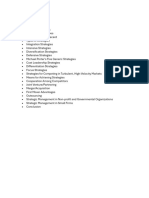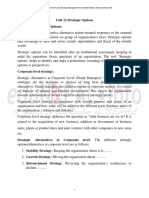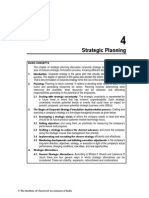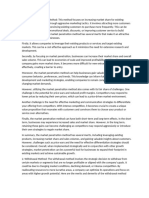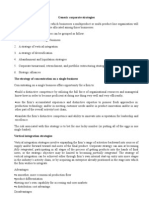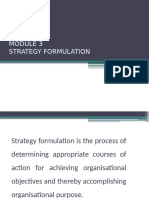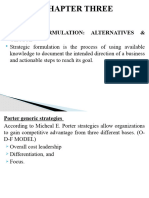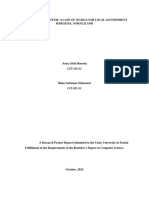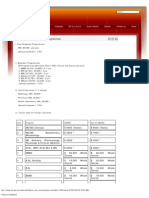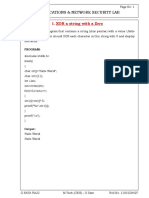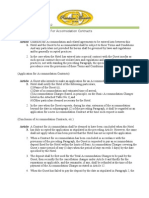Mba - Class Two
Mba - Class Two
Uploaded by
mohamoud BileCopyright:
Available Formats
Mba - Class Two
Mba - Class Two
Uploaded by
mohamoud BileOriginal Title
Copyright
Available Formats
Share this document
Did you find this document useful?
Is this content inappropriate?
Copyright:
Available Formats
Mba - Class Two
Mba - Class Two
Uploaded by
mohamoud BileCopyright:
Available Formats
UNIT 2- Strategy Formulation
Strategy formulation and choice are critical processes within strategic management
that guide organizations in achieving their objectives and responding effectively to
market dynamics. When considering strategies like modernization and
diversification, it’s vital to understand their definitions, implementation
considerations, and potential benefits and challenges.
Modernization
Definition: Modernization refers to the process of updating an organization's
practices, technologies, and processes to improve efficiency, productivity, and
competitiveness. This could involve adopting new technologies, redesigning
workflows, upgrading equipment, or integrating new management practices.
Key Elements:
1. Technology Upgrade: Implementing the latest technology to streamline
operations, improve product quality, and enhance customer engagement.
2. Process Improvement: Re-engineering processes to eliminate inefficiencies
and reduce costs.
3. Cultural Shift: Encouraging a culture of innovation and adaptability within
the workforce.
4. Training and Development: Investing in employee skill development to keep
pace with modern practices and technologies.
Benefits:
Improved operational efficiency and reduced costs.
Enhanced customer satisfaction through better products/services.
Increased competitiveness in the marketplace.
Challenges:
Resistance to change from employees.
Significant investment costs.
Risk of disruption during the transition period.
CPA AYMAN KIWEEWA 0657449580 1
Diversification
Definition: Diversification is a strategy that involves entering into new markets or
industries, often by developing new products or services, to reduce dependence on
existing markets and spread risk.
Key Elements:
1. Market Development: Expanding into new geographical markets or
customer segments.
2. Product Development: Introducing new products or services that
complement existing offerings.
3. Acquisition: Purchasing or merging with other companies to gain access to
new markets or technologies.
Types of Diversification:
Horizontal Diversification: Adding new products or services to existing lines
that are related to current business.
Vertical Diversification: Expanding into different stages of production
within the same industry (backward or forward integration).
Conglomerate Diversification: Entering entirely different industries or
markets unrelated to current operations.
Benefits:
Reduced risk by spreading investments across various markets.
Opportunities for larger market share and revenue growth.
Enhanced innovation through new product development.
Challenges:
Lack of expertise in new markets may lead to initial failures.
Increased complexity in management and operations.
Potential dilution of brand identity and focus.
CPA AYMAN KIWEEWA 0657449580 2
Conclusion
Both modernization and diversification are vital strategies for organizations aiming
to sustain long-term success. When formulating and choosing between these
strategies, it’s essential to:
Conduct a thorough market analysis.
Assess organizational capabilities and readiness for change.
Consider the financial implications of each strategy.
Engage stakeholders throughout the process to ensure alignment and
commitment.
Ultimately, the decision depends on the organization's current state, market
conditions, and long-term strategic objectives. Balancing both strategies can also
be beneficial, modernizing existing operations while seeking opportunities for
diversification.
Integration - Merger, take-over and joint strategies - Turnaround,
Integration strategies such as mergers, takeovers, and joint ventures are critical for
organizations seeking growth, market expansion, or enhanced competitive
advantage. These strategies can also play a significant role in turnaround scenarios
where companies aim to recover from financial distress or underperformance.
Here’s an overview of these concepts and their interrelation with turnaround
strategies.
Integration Strategies
1. Mergers
Definition: A merger occurs when two companies combine to form a new entity,
typically with a shared vision and strategy. It often aims to create synergies that
enhance efficiency and market reach.
Key Elements:
Joint Decision-Making: Both parties negotiate and agree on the terms of the
merger.
CPA AYMAN KIWEEWA 0657449580 3
Shared Resources: The resulting entity often benefits from combined
resources, capabilities, and market presence.
Cultural Integration: Merging company cultures can be challenging,
requiring careful attention to employee morale and engagement.
Benefits:
Enhanced market reach and customer base.
Economies of scale resulting in cost savings.
Increased capabilities through shared expertise and resources.
Challenges:
Cultural clashes between merging organizations.
Difficulties in integrating systems, processes, and personnel.
Potential regulatory hurdles and antitrust concerns.
2. Takeovers
Definition: A takeover involves one company acquiring another, either through
purchasing a significant shareholding to gain control or through a buyout. This can
be friendly or hostile.
Key Elements:
Acquisition Strategy: The acquiring company outlines its rationale for the
takeover and targets specific companies.
Control and Management: The acquiring company typically takes full
control and may implement changes in management and operations.
Post-Acquisition Integration: This involves integrating the acquired
company's operations, culture, and systems into the parent organization.
Benefits:
Accelerated growth by acquiring established markets or technologies.
Immediate access to new customer bases and distribution channels.
Potentially eliminating competition.
CPA AYMAN KIWEEWA 0657449580 4
Challenges:
High costs and financial risk associated with acquisitions.
Integration issues that might arise, similar to those in mergers.
Resistance from employees of the acquired company.
3. Joint Ventures
Definition: A joint venture is a strategic alliance where two or more companies
collaborate on a specific project or business activity, sharing resources, risks, and
profits while maintaining their independent statuses.
Key Elements:
Shared Investment: Companies invest resources and capital into a new
enterprise.
Defined Scope: The project or joint venture’s objectives, duration, and
governance structure are clearly defined.
Risk Sharing: Companies share both the risks and rewards, which can make
it easier to enter new markets.
Benefits:
Access to new markets and technologies without full acquisition costs.
Shared knowledge and expertise from different business cultures.
Reduced financial risk associated with expansion.
Challenges:
Potential for conflict over decision-making and management.
Differing objectives or levels of commitment from partnering companies.
Regulatory limitations or scrutiny.
Turnaround Strategies
Turnaround strategies are implemented when a company faces significant
challenges or underperformance. The goal is to reverse negative trends and restore
profitability. Integration strategies (mergers, takeovers, and joint ventures) can be
integral to this process.
CPA AYMAN KIWEEWA 0657449580 5
Key Aspects of Turnaround Strategies:
1. Financial Restructuring: This may involve mergers or takeovers to inject
capital, reduce debt, or streamline operations.
2. Operational Efficiency: Utilizing a merger or joint venture to enhance
operational capabilities and drive efficiencies.
3. Market and Product Realignment: Acquiring companies with
complementary products or entering joint ventures to access new markets
can revitalizing growth.
4. Leadership Changes: Implementing a takeover may lead to new leadership,
invigorating the company's strategic direction.
Benefits of Integration in Turnaround:
Quick infusion of resources and expertise to address pressing issues.
Improved market position and customer confidence.
Alignment of strategic objectives among partners.
Challenges of Integration in Turnaround:
Possible integration paralysis if resources are focused on merging instead of
turnaround execution.
Loss of focus on core business operations during the integration process.
The need for careful change management to ensure cultural alignment and
employee buy-in.
Conclusion
Mergers, takeovers, and joint ventures are powerful tools within integration
strategies that can play a crucial role in turnaround efforts. When effectively
executed, these strategies enable companies to enhance their market position,
optimize resources, and foster innovation. However, careful consideration of
cultural, financial, and operational factors is essential to ensure successful
execution and long-term sustainability. Companies must navigate the complexities
of integration while remaining focused on their turnaround goals to achieve a
successful revival.
CPA AYMAN KIWEEWA 0657449580 6
Divestment and Liquidation strategies - Strategic choice - Industry,
Divestment and liquidation strategies are important components of a business's
strategic management process, particularly in the context of organizational
restructuring or reacting to market dynamics. Understanding when and how to
implement these strategies is crucial for firms looking to optimize their portfolios,
refocus on core operations, or exit less profitable markets. Below is an overview of
divestment and liquidation strategies that incorporates the concepts of strategic
choice and industry considerations.
Divestment Strategies
Definition: Divestment is the process of selling off a business unit, asset, or
subsidiary. Companies may choose to divest for various reasons, including poor
performance, a shift in strategic focus, or the need to raise capital.
Key Elements:
1. Identification of Non-Core Assets: Companies must evaluate their
portfolio to determine which divisions or assets do not align with their core
strategy or are underperforming.
2. Market Analysis: Understanding the market conditions and potential buyers
helps companies determine the right timing and price for divestment.
3. Execution of Sale: The divesting company may utilize various methods,
including selling to competitors, private equity firms, or through public
offerings.
Benefits:
Improved focus on core competencies and strategic objectives.
Increased liquidity and capital that can be reinvested in more profitable
areas.
Reduction of operational complexities and costs associated with
underperforming segments.
CPA AYMAN KIWEEWA 0657449580 7
Challenges:
Possible negative impact on employee morale and company culture.
Potential loss of synergies and revenue streams associated with divested
units.
The complexity of negotiations and ensuring a successful transition for the
buyer.
Liquidation Strategies
Definition: Liquidation involves closing down a business and selling its assets to
pay off creditors. This strategy is usually considered when a company is no longer
viable or when its continuation is no longer in the best interest of stakeholders.
Key Elements:
1. Assessment of Viability: Before liquidation, organizations must assess their
financial position and market conditions to confirm that liquidation is the
best course of action.
2. Asset Valuation: Accurately valuing assets is crucial to maximizing returns
during the liquidation process. This includes physical assets, inventory,
intellectual property, and other resources.
3. Debt Settlement: Liquidation involves settling debts with creditors,
prioritizing payments according to legal and contractual obligations.
Benefits:
Recovery of some value from remaining assets to satisfy creditors.
Clear exit from an unviable business, allowing stakeholders to move on.
Simplification of accountancy and closure processes.
Challenges:
Potential losses for creditors, employees, and shareholders.
Negative impact on reputation and relationships with stakeholders.
Legal complexities, including potential lawsuits or claims from creditors.
CPA AYMAN KIWEEWA 0657449580 8
Strategic Choice
The strategic choice between divestment and liquidation is influenced by several
factors, including:
1. Industry Dynamics:
o Growth vs. Decline: In a growth industry, divestment might be
preferred to focus on strengthening core offerings, while liquidation
may be more common in declining industries where continued
operations are unsustainable.
o Market Position: Companies with strong market positions may opt
for divestment to unlock value from non-core assets. In contrast, firms
that are struggling may have no viable alternative but to liquidate.
2. Financial Health:
o Organizations with healthy financials might choose divestment as a
strategic choice to reposition themselves, while those in dire financial
situations may need to liquidate to mitigate losses.
3. Strategic Objectives:
o The decision largely depends on the company's long-term strategic
objectives. If the goal is to streamline and refocus efforts on core
areas, divestment is typically preferred. Conversely, if the business
model is fundamentally flawed or assets are heavily impaired,
liquidation may be necessary.
Conclusion
Both divestment and liquidation strategies serve as vital tools for organizations
responding to market conditions, changing consumer preferences, and shifts in
strategic direction. The choice between them should be informed by a careful
analysis of the industry landscape, financial health, and overarching strategic goals.
By effectively navigating these complex decisions, companies can optimize their
portfolios, ensure long-term sustainability, and allocate resources towards their
most promising opportunities. Understanding the implications of each strategy will
allow leaders to make informed choices that align with their desired outcomes in a
dynamic business environment.
CPA AYMAN KIWEEWA 0657449580 9
Competitor Analysis
Definition: Competitor analysis involves assessing the strengths and weaknesses
of current and potential competitors within a market. This process informs a
company about how to position itself competitively.
Key Components:
1. Identification of Competitors: Understanding which companies operate in
the same market segment, including direct, indirect, and emerging
competitors.
2. Market Positioning: Analyzing how competitors position themselves in
terms of pricing, quality, market share, and value propositions.
3. Competitive Strategies: Evaluating competitors' strategies, such as product
development, marketing tactics, distribution channels, and customer
engagement.
4. Strengths and Weaknesses: Assessing the core capabilities of competitors,
including their resources, technological advantages, and brand reputation.
Factors Affecting Strategic Choice from Competitor Analysis:
Market Saturation: A saturated market may prompt a company to
differentiate itself through innovation or targeting niche segments.
Competitive Advantage: Organizations must understand their unique
selling propositions (USPs) relative to competitors and capitalize on those to
make strategic choices.
Threat of New Entrants: The ease or difficulty of new competitors entering
the market can influence strategies related to pricing, marketing, and product
development.
Barriers to Entry: High barriers may allow existing players more stability,
influencing decisions on expansion or diversification.
CPA AYMAN KIWEEWA 0657449580 10
SWOT Analysis
Definition: SWOT analysis is a tool used to assess an organization’s internal
strengths and weaknesses, as well as external opportunities and threats. It
supports strategic planning by providing a holistic view of the organization's
position.
Components:
1. Strengths: Internal attributes that provide advantages over competitors
(e.g., strong brand reputation, proprietary technology, skilled
workforce).
2. Weaknesses: Internal limitations that pose challenges (e.g., high debt
levels, lack of expertise, operational inefficiencies).
3. Opportunities: External factors that the organization can leverage for
growth (e.g., market trends, technological advancements, regulatory
changes).
4. Threats: External challenges that could impede success (e.g., economic
downturns, increased competition, changes in consumer preferences).
Factors Affecting Strategic Choice from SWOT Analysis:
Alignment with Strengths: Organizations are more likely to pursue
strategies that leverage their core strengths, such as capitalizing on a
strong brand to enter new markets.
Mitigation of Weaknesses: Strategic choices may involve addressing
weaknesses through partnerships, acquisitions, or investments in
capability building.
Exploitation of Opportunities: Companies often prioritize strategies
that maximize external opportunities, like entering a growing market or
adopting new technologies.
Defense Against Threats: Understanding potential threats can shape
defensive strategies aimed at risk mitigation, such as diversifying
offerings or enhancing competitive positions.
CPA AYMAN KIWEEWA 0657449580 11
Interconnection of Competitor and SWOT Analysis
1. Strategic Insights: Both analyses provide critical insights for decision-
making, helping businesses understand market dynamics and their internal
capacities.
2. Competitive Positioning: Insights from competitor analysis inform the
SWOT analysis about how external elements impact the organization’s
strengths and weaknesses and the viability of certain strategic choices.
3. Market Responsiveness: An ongoing competitor analysis enables
organizations to remain agile, adapting their SWOT assessments and
strategic choices based on competitive actions, market trends, and changes
in consumer behavior.
Conclusion
Competitor and SWOT analyses are integral to strategic planning, providing
organizations with a framework to evaluate their market standing and make
informed strategic choices. Factors affecting these strategic choices include market
dynamics, organizational resources, competitive advantages, and environmental
threats and opportunities.
Generic competitive strategies - Cost leadership, Differentiation, Focus,
Generic competitive strategies, as proposed by Michael Porter, outline how a
company can gain a competitive advantage in the market. These strategies help
businesses position themselves effectively against competitors and cater to
customer needs. They are categorized into three primary strategies: cost leadership,
differentiation, and focus. Below is a detailed discussion of each strategy:
1. Cost Leadership
Definition: Cost leadership is a strategy where a company aims to become the low-
cost producer in its industry. The focus is on gaining a competitive edge by
lowering production and operational costs, allowing the company to offer lower
prices to customers or achieve higher margins.
CPA AYMAN KIWEEWA 0657449580 12
Key Characteristics:
Economies of Scale: Achieving cost advantages through high volume
production.
Efficient Operations: Streamlining processes, reducing waste, and
optimizing resource usage.
Supply Chain Management: Securing low-cost raw materials and
optimizing logistics to minimize costs.
Technology Utilization: Implementing cost-efficient technologies to
enhance productivity.
Advantages:
Ability to attract price-sensitive customers.
Protection against competitive pressures; a lower cost structure allows for
flexibility in pricing strategies.
Higher profit margins compared to competitors when selling at industry
average prices.
Challenges:
Risk of reduced quality perception among consumers.
Limited ability to respond to market changes or customer preferences if
overly focused on cost.
Competitors may erode price advantages through innovation or improved
efficiency.
2. Differentiation
Definition: Differentiation is a strategy where a company seeks to offer unique
products or services that provide greater value to customers compared to
competitors. This can be achieved through innovation, quality, brand perception,
customer service, or other attributes.
Key Characteristics:
Unique Value Proposition: Offering features or benefits that stand out to
consumers.
CPA AYMAN KIWEEWA 0657449580 13
Branding and Marketing: Strong brand identity and effective marketing
strategies to communicate product uniqueness.
Quality and Innovation: Continuous investment in research and
development to enhance products and respond to market needs.
Customer Experience: Focus on providing superior customer service and
engagement.
Advantages:
Ability to charge premium prices due to perceived added value.
Customer loyalty resulting from unique offerings and brand reputation.
Less direct competition from firms in the same segment, leading to higher
market power.
Challenges:
Increased costs related to R&D and marketing efforts.
Risk of imitation by competitors, which may dilute differentiation.
Need for continual innovation and adaptation to maintain differentiated
status.
3. Focus (Focus Strategy)
Definition: The focus strategy involves concentrating on a specific market niche or
segment. Companies employing this strategy either achieve cost leadership or
differentiation within that niche. This allows them to better serve the specialized
needs of a defined group of customers.
Key Characteristics:
Targeted Marketing: Focusing on a narrow market segment with specific
needs or preferences.
Customization: Tailoring products or services to fit the unique requirements
of the target market.
Expertise and Customer Relationships: Developing deep knowledge
about the chosen market segment, fostering strong customer relationships.
CPA AYMAN KIWEEWA 0657449580 14
Advantages:
Lower competition from larger companies that target broader markets.
Strong brand loyalty from customers who feel their specific needs are met.
Ability to charge premium prices due to customization or specialized
offerings.
Challenges:
Potential vulnerability to changes in market trends; a narrow focus can be
risky if the market shrinks.
Limited growth potential if the target market is too small.
Larger competitors may adopt a similar focused strategy and challenge niche
players.
Conclusion
Understanding and choosing among Porter's generic competitive strategies—cost
leadership, differentiation, and focus—is critical for organizations seeking to
establish or maintain a competitive advantage in their respective industries. Each
strategy involves distinct advantages and challenges, and the choice depends on the
company’s capabilities, market conditions, and customer needs. Companies may
also switch strategies or combine elements of different strategies to adapt to
changing market dynamics. Ultimately, the successful implementation of a chosen
strategy is integral to achieving long-term business sustainability and profitability.
CPA AYMAN KIWEEWA 0657449580 15
Value chain analysis, Bench marking, Service blue printing
Value Chain Analysis, Benchmarking, and Service Blueprinting are essential tools
for organizations aiming to improve processes, enhance customer satisfaction, and
achieve competitive advantages. Each tool serves a specific purpose and can be
utilized in tandem to achieve strategic objectives. Below is a detailed overview of
each method:
1. Value Chain Analysis
Definition: Value Chain Analysis, introduced by Michael Porter, is a method used
to identify the primary and support activities that create value for a company’s
products or services. By analyzing these activities, organizations can understand
their cost structures and find areas for improvement.
Key Components:
Primary Activities: These are directly related to the creation and delivery of
a product or service and include:
o Inbound Logistics: Receiving and warehousing inputs.
o Operations: Processes that transform inputs into finished goods.
o Outbound Logistics: Activities required to get the finished product to
customers.
o Marketing and Sales: Strategies to promote and sell the product.
o Service: After-sales support and services provided to customers.
Support Activities: These activities facilitate primary activities and include:
o Firm Infrastructure: Company systems, organization, and
management.
o Human Resource Management: Recruitment, hiring, and employee
development.
o Technology Development: R&D, technological improvements, and
product development.
o Procurement: Acquiring goods and services necessary for operations.
CPA AYMAN KIWEEWA 0657449580 16
Benefits:
Cost Reduction: Identifies inefficiencies and cost drivers across the value
chain.
Differentiation Opportunities: Highlights areas where unique value can be
added.
Strategic Insights: Enhances understanding of how activities interrelate and
contribute to competitive advantage.
2. Benchmarking
Definition: Benchmarking is the process of comparing a company’s processes,
products, services, or performance metrics to industry best practices or standards
from other organizations to identify areas for improvement.
Key Types:
Internal Benchmarking: Comparing metrics and processes within different
departments or units of the same organization.
Competitive Benchmarking: Comparing with direct competitors to
evaluate relative performance.
Functional Benchmarking: Looking at similar functions in non-
competitive organizations to gain insights.
Generic Benchmarking: Comparing processes and practices that are similar
across different industries.
Process:
1. Identify Metrics: Determine what processes or performance metrics will be
benchmarked.
2. Select Benchmarking Partners: Identify organizations recognized for their
best practices.
3. Data Collection: Gather data on performance metrics from both the
organization and its benchmarks.
4. Analysis: Identify gaps in performance, processes, and practices.
5. Action Plan: Develop strategies to close performance gaps based on
recommendations from the analysis.
CPA AYMAN KIWEEWA 0657449580 17
Benefits:
Performance Improvement: Aligns processes with best practices to
enhance efficiency.
Competitive Insight: Provides understanding of competitive positioning.
Innovation: Encourages the adoption and adaptation of best practices within
the organization.
3. Service Blueprinting
Definition: Service Blueprinting is a visualization method that enables
organizations to understand and design service processes, focusing on customer
interactions, service delivery, and the back-end processes that support service
execution.
Key Components:
1. Customer Actions: The steps that customers take during their interaction
with the service.
2. Frontstage (Visible Contact Employee Actions): Actions by employees
that are visible to the customer.
3. Backstage (Invisible Contact Employee Actions): Employee activities not
directly visible to customers but essential to service delivery.
4. Support Processes: Internal processes and systems that support both
frontstage and backstage actions.
5. Physical Evidence: Tangibles that customers encounter during the service
experience, like brochures, digital interfaces, or the physical environment.
Benefits:
Process Improvement: Identifies bottlenecks and inefficiencies in service
delivery.
Customer Experience Enhancement: Maps the customer journey, allowing
for improvements in the customer experience.
Stakeholder Alignment: Facilitates communication and alignment among
various stakeholders regarding service processes.
CPA AYMAN KIWEEWA 0657449580 18
Integrating the Tools
These three tools—Value Chain Analysis, Benchmarking, and Service
Blueprinting—can be used collectively to enhance organizational performance:
Value Chain Analysis can identify key activities that may benefit
from Benchmarking, leading to performance enhancements.
Insights from Benchmarking can inform Service Blueprinting, allowing
organizations to adopt best practices in service delivery.
Service Blueprinting can reveal customer pain points and opportunities for
differentiation that can be analyzed through Value Chain Analysis.
Conclusion
Value Chain Analysis, Benchmarking, and Service Blueprinting are powerful
methodologies that provide organizations with valuable insights into their
operations and service delivery. By analyzing internal processes, comparing with
industry standards, and mapping customer journeys, companies can improve their
efficiency, enhance customer satisfaction, and maintain a strong competitive
position in the market. Each tool has its unique strengths and can be effectively
integrated to drive continuous improvement and strategic success.
END
CPA AYMAN KIWEEWA 0657449580 19
You might also like
- Understanding Mergers and Acquisitions (M&A) Introduction: Mergers and Acquisitions (M&A) Are Complex Financial Transactions That InvolveNo ratings yetUnderstanding Mergers and Acquisitions (M&A) Introduction: Mergers and Acquisitions (M&A) Are Complex Financial Transactions That Involve2 pages
- Group 12 Stability Strategy Growth StrategyNo ratings yetGroup 12 Stability Strategy Growth Strategy28 pages
- Unit-5: Business Planning in Different EnvironmentsNo ratings yetUnit-5: Business Planning in Different Environments60 pages
- Lecturenote - 77328274chapter Two Strategic MGT - 2No ratings yetLecturenote - 77328274chapter Two Strategic MGT - 211 pages
- Strategic Management: Business Strategies and Corporate StrategiesNo ratings yetStrategic Management: Business Strategies and Corporate Strategies22 pages
- Part A Explain The Justification For Business Diversification and ExpansionNo ratings yetPart A Explain The Justification For Business Diversification and Expansion15 pages
- Corporate Strategy (Year 21-22) Semester ANSWERNo ratings yetCorporate Strategy (Year 21-22) Semester ANSWER24 pages
- Strategic Interventions in Change ManagementNo ratings yetStrategic Interventions in Change Management5 pages
- Chapter 4: Strategy Formulation and Business Level Strategic ActionNo ratings yetChapter 4: Strategy Formulation and Business Level Strategic Action4 pages
- Grand Strategies N Strategy Selection ModelsNo ratings yetGrand Strategies N Strategy Selection Models42 pages
- Supply Chain Management Chapter 2: Strategic Procurement Dr. Pramod MatoliaNo ratings yetSupply Chain Management Chapter 2: Strategic Procurement Dr. Pramod Matolia25 pages
- Deloitte-Ch-En-Strategic-Cost - TransformationNo ratings yetDeloitte-Ch-En-Strategic-Cost - Transformation9 pages
- MBA 2 NOTES Corporate Strategy (UNIT-3) 2024No ratings yetMBA 2 NOTES Corporate Strategy (UNIT-3) 202468 pages
- Lesson 3: Note That A Corporate-Level Strategy Should Help The Firm Earn Above-Average Returns by Creating ValueNo ratings yetLesson 3: Note That A Corporate-Level Strategy Should Help The Firm Earn Above-Average Returns by Creating Value4 pages
- Corporate Level Strategy Addresses The Entire Strategic Scope of The FirmNo ratings yetCorporate Level Strategy Addresses The Entire Strategic Scope of The Firm19 pages
- SMCG MODULE-3 The Strategic Alternatives: Levels at Which Strategy OperatesNo ratings yetSMCG MODULE-3 The Strategic Alternatives: Levels at Which Strategy Operates19 pages
- Strategic Analysis of Internal Environment of a Business OrganisationFrom EverandStrategic Analysis of Internal Environment of a Business OrganisationNo ratings yet
- FINAL_Online Voting System_asiya & Bilan (2)No ratings yetFINAL_Online Voting System_asiya & Bilan (2)52 pages
- PDF Handbook of Polish Czech and Slovak Holocaust Fiction Works and Contexts 1st Edition Elisa-Maria Hiemer (Editor) Download100% (2)PDF Handbook of Polish Czech and Slovak Holocaust Fiction Works and Contexts 1st Edition Elisa-Maria Hiemer (Editor) Download69 pages
- Franz Schubert and His Times - Kobald, Karl, 1876 - Marshall, Beatrice, TR - 1970 - Port Washington, N.Y., Kennikat Press - 9780804607568 - Anna's ArchiveNo ratings yetFranz Schubert and His Times - Kobald, Karl, 1876 - Marshall, Beatrice, TR - 1970 - Port Washington, N.Y., Kennikat Press - 9780804607568 - Anna's Archive328 pages
- Bangabandhu Sheikh Mujibur Rahman Science and Technology UniversityNo ratings yetBangabandhu Sheikh Mujibur Rahman Science and Technology University3 pages
- Tools & Consumables Consumption Report Rev 1No ratings yetTools & Consumables Consumption Report Rev 16 pages
- ABD0004 Electrical Graphic Symbols Part 4 HNo ratings yetABD0004 Electrical Graphic Symbols Part 4 H102 pages
- Session 03 Gathering The Information and Scanning The EnvironmentNo ratings yetSession 03 Gathering The Information and Scanning The Environment31 pages
- UPSC IAS Prelims GS - General Studies Question Paper 1995 With AnswersNo ratings yetUPSC IAS Prelims GS - General Studies Question Paper 1995 With Answers47 pages
- Mitchell Board of Education Feb. 26 Meeting AgendaNo ratings yetMitchell Board of Education Feb. 26 Meeting Agenda33 pages
- Terms and Conditions For Accomodation ContractsNo ratings yetTerms and Conditions For Accomodation Contracts6 pages
- Understanding Mergers and Acquisitions (M&A) Introduction: Mergers and Acquisitions (M&A) Are Complex Financial Transactions That InvolveUnderstanding Mergers and Acquisitions (M&A) Introduction: Mergers and Acquisitions (M&A) Are Complex Financial Transactions That Involve
- Unit-5: Business Planning in Different EnvironmentsUnit-5: Business Planning in Different Environments
- Lecturenote - 77328274chapter Two Strategic MGT - 2Lecturenote - 77328274chapter Two Strategic MGT - 2
- Strategic Management: Business Strategies and Corporate StrategiesStrategic Management: Business Strategies and Corporate Strategies
- Part A Explain The Justification For Business Diversification and ExpansionPart A Explain The Justification For Business Diversification and Expansion
- Chapter 4: Strategy Formulation and Business Level Strategic ActionChapter 4: Strategy Formulation and Business Level Strategic Action
- Supply Chain Management Chapter 2: Strategic Procurement Dr. Pramod MatoliaSupply Chain Management Chapter 2: Strategic Procurement Dr. Pramod Matolia
- Lesson 3: Note That A Corporate-Level Strategy Should Help The Firm Earn Above-Average Returns by Creating ValueLesson 3: Note That A Corporate-Level Strategy Should Help The Firm Earn Above-Average Returns by Creating Value
- Corporate Level Strategy Addresses The Entire Strategic Scope of The FirmCorporate Level Strategy Addresses The Entire Strategic Scope of The Firm
- SMCG MODULE-3 The Strategic Alternatives: Levels at Which Strategy OperatesSMCG MODULE-3 The Strategic Alternatives: Levels at Which Strategy Operates
- Strategic Analysis of Internal Environment of a Business OrganisationFrom EverandStrategic Analysis of Internal Environment of a Business Organisation
- PDF Handbook of Polish Czech and Slovak Holocaust Fiction Works and Contexts 1st Edition Elisa-Maria Hiemer (Editor) DownloadPDF Handbook of Polish Czech and Slovak Holocaust Fiction Works and Contexts 1st Edition Elisa-Maria Hiemer (Editor) Download
- Franz Schubert and His Times - Kobald, Karl, 1876 - Marshall, Beatrice, TR - 1970 - Port Washington, N.Y., Kennikat Press - 9780804607568 - Anna's ArchiveFranz Schubert and His Times - Kobald, Karl, 1876 - Marshall, Beatrice, TR - 1970 - Port Washington, N.Y., Kennikat Press - 9780804607568 - Anna's Archive
- Bangabandhu Sheikh Mujibur Rahman Science and Technology UniversityBangabandhu Sheikh Mujibur Rahman Science and Technology University
- Session 03 Gathering The Information and Scanning The EnvironmentSession 03 Gathering The Information and Scanning The Environment
- UPSC IAS Prelims GS - General Studies Question Paper 1995 With AnswersUPSC IAS Prelims GS - General Studies Question Paper 1995 With Answers
- Mitchell Board of Education Feb. 26 Meeting AgendaMitchell Board of Education Feb. 26 Meeting Agenda




